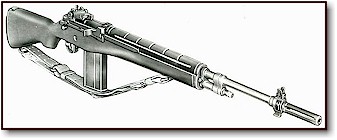The Re-emergence of the M14
The
Soldier of Fortune
magazine for May 2005 contains interesting
information on the re-issue of M14s to certain US
troops being posted to Iraq. Comment from John
Farnam's Combat Weaponcraft goes as
follows:
"Beating us to it, British Special Ops folks in
that part of the world have already 'rediscovered'
the •303 Enfield cartridge." ...
"It's
(i.e. the 7•62 x 51 or •308 cartridge — Ed.) a
tremendous force multiplier," we are told.
Isn't every battle rifle supposed
to fit that description? What does that make the
M16 and M4? A non-force-multiplier and a non-asset
on the battlefield? ...
"What no one will say (in public) is that, in a
battle rifle, the 223 round is a joke, critically
lacking in both range and penetration, yet another
sad leftover from the lamentable Johnson
administration. It is embarrassing that it has
taken so long for this 40-year-old procurement
mistake finally to be addressed."
All this is an interesting development seeing that
the Remington 6•8
x 43 SP cartridge has been allowed to languish.
Perhaps a little history may be in order.
 WWII
combat experience in Europe convinced the ordnance
experts of many countries that the full power
rifle cartridges in vogue (e.g. 30-06, •303, 8 x
57) were overly powerful, and that a less powerful
cartridge such as the German 8 x 33 Sturmgewehr
cartridge was the way to go.
WWII
combat experience in Europe convinced the ordnance
experts of many countries that the full power
rifle cartridges in vogue (e.g. 30-06, •303, 8 x
57) were overly powerful, and that a less powerful
cartridge such as the German 8 x 33 Sturmgewehr
cartridge was the way to go.
Accordingly, the U.S. in 1944 developed the T65
cartridge (a shortened 30-06) and it was later
known as the 7•62
x 51 or
•308
Winchester. Development of a modified, shortened
Garand with a 20 shot detachable magazine took
longer, but the final trials rifle, known as the
T44, was approved for production as the M14 in
1957. Actual production began in 1960, with four
contractors eventually supplying a total of
1,381,581 rifles, until production came to an
abrupt end in 1964. Contractors were the National
Armory of Springfield, Mass., Harrington and
Richardson of Worcester, Mass., Western-Winchester
Division of Olin Industries, New Haven, Conn., and
Thompson-Ramo-Woolridge Inc. of Cleveland, Ohio.
The new player and usurper of the M14 programme
was the AR15/M16 "Black Rifle", known in some
disapproving circles as the "Pentagon Pansy",
but that is another long, involved story.
By the time the M14 programme was officially ended
work had already stopped, and in 1967 the M14
production machinery was sold to the Republic of
China (Taiwan). I have heard stories that passable
copies had been made by the Communist Chinese arms
factories on the mainland. Perhaps somebody can
confirm or deny this.

Originally the M14 was intended for use with a
full auto selector switch, but most were issued
with a semi-automatic mechanism. The semi-auto
versions were unofficially known as the M14(M)
i.e. modified. A notable derivative was the M21
sniper version, which had a favourable reputation.
.
I just wonder how many SLRs the Australian Army
has in reserve, or have we given them all away to
Indonesia?